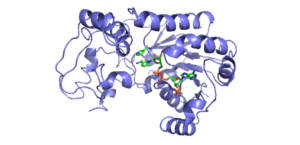Dániel Mokos1, Anna Schrüfer1, Jernej Jurič1, Tamara Berger1,
Karl Gruber1,2, Bastian Daniel1,2
1University of Graz, Institute of Molecular Biosciences, Graz, Austria
2BioTechMed, Graz, Austria

The tobacco industry is a multi-billion-dollar business1 built up solely on the physiological effects of nicotine. Although tobacco is a major player in global economics, some steps in the nicotine biosynthesis are still poorly understood. The initial steps are well characterized, while for the later steps enzymes have been postulated but their exact function has never been shown in vitro.2 A622 has been shown to play a crucial role in the alkaloid biosynthesis [3,4], therefore our current goal is the structural and functional characterization of A622. Since the native form of A622 from Nicotiana tabacum was difficult to express and purify we tried to characterize the natural homologues from other alkaloid producing plants, as well as obtaining theoretical progenitors of our protein by ancestral sequence reconstruction with similar function but higher stability as previously demonstrated by Mattevi et al.5 We were able to recombinantly produce and purify six A622 homologues found in nature in nicotine producing plants, as well as two ancestral variants, and set up crystallisation trials with them. Protein crystals were obtained under various conditions for one of the ancestors, and a complete data set was collected for structure determination, and the structure was solved at a resolution of 1.3 Å (Figure 1). This helped us propose a binding mechanism as-well as predict the activity of the protein. At the current stage of the project experimental enzymatic essays are being carried out with the recombinant proteins, to prove the mechanism and identify the product. References:
References:
[1] Statista. (June 16, 2021). Value of the tobacco market worldwide from 2012 to 2025 (in million U.S. dollars) [Graph]. In Statista. Retrieved March 18, 2022, from https://www.statista.com/forecasts/1098876/tobacco-global-market-value
[2] Xu S, Brockmöller T, Navarro-Quezada A, Kuhl H, Gase K, Ling Z et al. Proceedings of the National Academy of Sciences of the United States of America. 2017;114(23): 6133-6138. doi:10.1073/pnas.1700073114
[3] M. Kajikawa, N. Hirai, T. Hashimoto, Plant Mol Biol. 2009;69: 287–298. doi:10.1007/s11103-008-9424-3
[4] K.D. DeBoer, J.C.Lye, C.D. Aitken CD, A.K.K. Su, J.D. Hamill, Plant Mol Biol. 2009;69: 299–312. doi:10.1007/s11103-008-9425-2
[5] Nicoll, C.R.; Bailleul, G.; Fiorentini, F.; Mascotti, M.L.; Fraaije, M.W. and Mattevi, A, Nature Structural & Molecular Biology, 2020; 1: 14–24. doi:10.1038/s41594-019-0347-2
Keywords: nicotine; A622; crystallography; biosynthesis; ancestral sequence reconstruction
